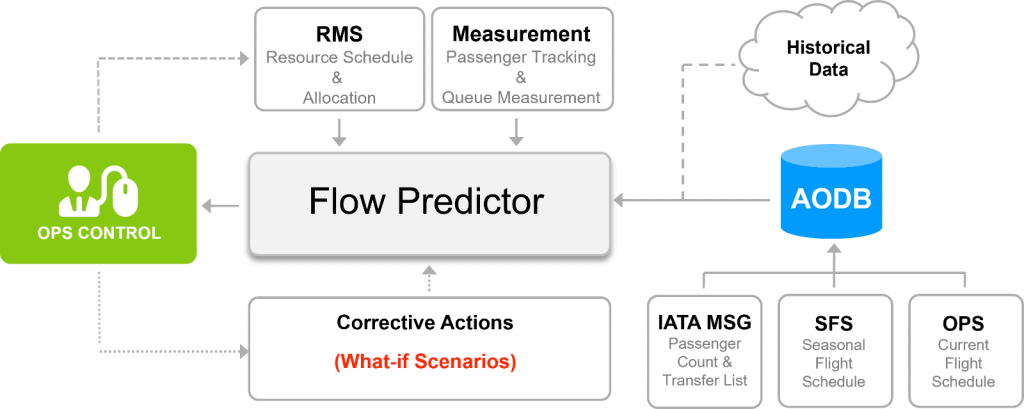application service
Passenger Flow Control
Proactive capacity management with passenger flow and resource load predictions.
Increasing passenger numbers and the continuous need to utilize existing capacity in the best possible way is an ongoing challenge for airports. In situations where passenger numbers decrease, efficiency must be maintained, and over-allocation of resources avoided. Passenger processing is also changing with additional checkpoints and the introduction of biometrics and self-service facilities. To operate efficiently and maintain service levels terminal operators need insight and guidance to be able to manage passenger flows and plan resources effectively.
With the Passenger Flow Prediction solution, end-to-end passenger flows are simulated to provide the most accurate prediction of the load at processing points over the next 24 hours indicating when the level of service targets will not be achieved. Planned and real-time flight data, historical data, old and new passenger behaviour patterns, terminal layout, and process point parameters, are combined with pedestrian behaviour algorithms and incorporated into an agent-based passenger simulation. The simulation runs continuously, and the predictions are updated based on real-time flight updates and changes in resource allocations.
manage & predict
AMORPH.aero Flow Predictor enables proactive management of terminal operations by providing accurate, real-time predictions of the passenger flow and the queue and waiting times at process points.
When changes in loads at process points are identified because estimated times of arrival for flights are early, or late, operations managers can respond proactively to avoid congestion by rerouting passengers or modifying resource allocations.
Online Dashboards provide fast and convenient access to KPIs, operations views, and predictions. To assist with the challenges of managing transfer flights the connection time for each group of transfer passengers and the calculated transfer time is displayed.
An important benefit of performing agent-based passenger simulation is that the real transfer time can be calculated, considering all queuing effects, as well as effects of passengers arriving at a service point before or after another group. In this way, compromised connections due to excessive time spent at process points can be identified, even though the passengers have adequate connection time.
Planning runs, the parameters used and the calculation bases, as well as the effects of changes in resources and infrastructure, are versioned and always available and visible. This enables close cooperation and collaborative decision making between planners, operational staff, and other stakeholders. The focus remains on passengers, their behaviour in the terminal, and the opportunities for improving operational and commercial performance.

manage & predict
AMORPH.aero Flow Predictor enables proactive management of terminal operations by providing accurate, real-time predictions of the passenger flow and the queue and waiting times at process points.
When changes in loads at process points are identified because estimated times of arrival for flights are early, or late, operations managers can respond proactively to avoid congestion by rerouting passengers or modifying resource allocations.
Online Dashboards provide fast and convenient access to KPIs, operations views, and predictions. To assist with the challenges of managing transfer flights the connection time for each group of transfer passengers and the calculated transfer time is displayed.
An important benefit of performing agent-based passenger simulation is that the real transfer time can be calculated, considering all queuing effects, as well as effects of passengers arriving at a service point before or after another group. In this way, compromised connections due to excessive time spent at process points can be identified, even though the passengers have adequate connection time.
Planning runs, the parameters used and the calculation bases, as well as the effects of changes in resources and infrastructure, are versioned and always available and visible. This enables close cooperation and collaborative decision making between planners, operational staff, and other stakeholders. The focus remains on passengers, their behaviour in the terminal, and the opportunities for improving operational and commercial performance.

// Take the next steps.
Connect with a solutions expert
Explore how AMORPH.aero solutions can address your requirements
Sign up for our newsletter
Get the latest news about AMORPH.aero delivered to your inbox